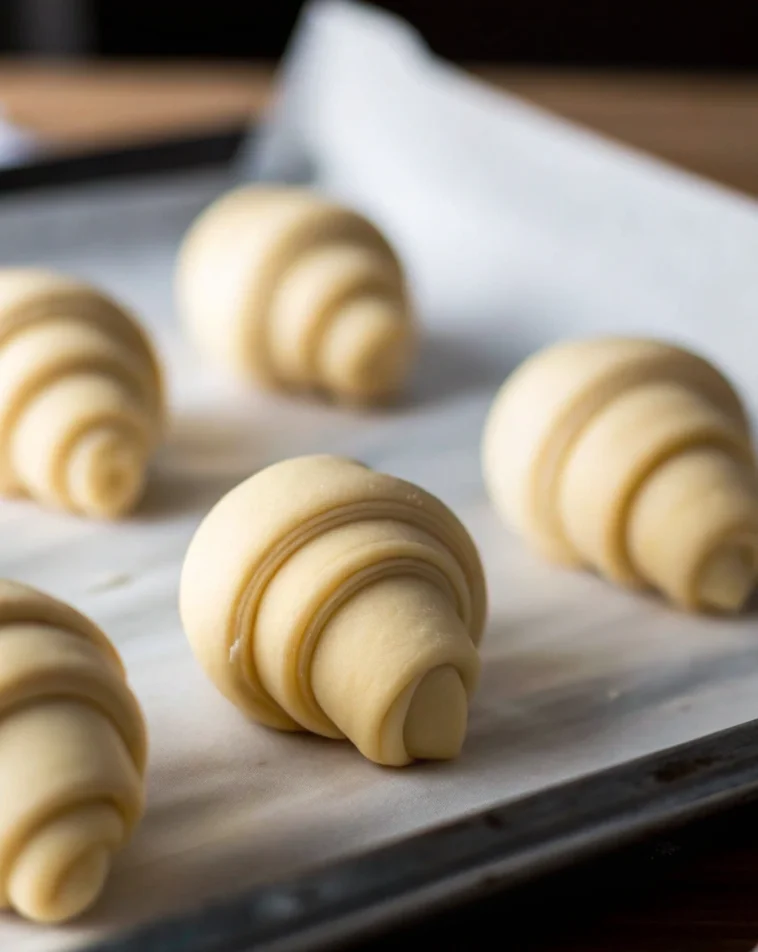Croissants are the epitome of buttery, flaky perfection. Whether served with a cup of coffee in the morning or filled with savory or sweet fillings, these delicate pastries never fail to impress. The process of making homemade croissants might seem daunting at first, but with the right approach and a bit of patience, you can craft the perfect croissant right in your own kitchen. In this guide, we’ll break down the steps with detailed measurements, tips, and variations to ensure your croissants come out as light, crisp, and flavorful as those from a bakery.
Introduction
Making croissants from scratch is a labor of love. The dough is layered with butter through a technique known as lamination, creating those signature flaky layers. The result is a delicious pastry that boasts a soft interior with a golden, crispy exterior. While the process involves multiple steps and time, the end product is well worth the effort. By following this guide, you’ll be able to create flaky homemade croissants that rival any bakery in taste and texture.
Recipe Overview
- Prep Time: 20 minutes (excluding resting time)
- Chill Time: 4 hours (approximately)
- Cook Time: 20-25 minutes
- Total Time: 5 hours 30 minutes
- Yield: 12 croissants
- Category: Pastry
- Method: Baking
- Cuisine: French
- Diet: Vegetarian (contains dairy)
- Keywords: homemade croissants, flaky croissants, buttery croissants, croissant recipe
Ingredients
To create the best homemade croissants, you’ll need the following ingredients. Each one plays an important role in the texture and flavor of your croissants.
For the Dough:
- 500g (4 cups) all-purpose flour
- 12g (2 tsp) salt
- 55g (1/4 cup) granulated sugar
- 10g (1 tbsp) active dry yeast
- 250ml (1 cup) whole milk, lukewarm
- 30g (2 tbsp) unsalted butter, softened
- 150ml (2/3 cup) cold water
For the Butter Block:
- 280g (1 1/4 cups) unsalted butter, cold and cut into cubes
For the Egg Wash:
- 1 large egg, beaten
- 1 tbsp water
Step-by-Step Instructions
Step 1: Prepare the Dough
- In a large bowl, combine the flour, salt, and sugar. Stir to mix evenly.
- In a separate bowl, dissolve the yeast in the lukewarm milk and let it sit for about 5 minutes until frothy.
- Pour the yeast mixture into the flour mixture along with cold water. Mix until the dough comes together, then knead for about 8-10 minutes on a lightly floured surface until it becomes smooth and elastic.
- Shape the dough into a ball, cover it with a clean towel, and let it rest for 1-1.5 hours in a warm place until it doubles in size.
Step 2: Prepare the Butter Block
- While the dough is resting, prepare the butter block. Take the cold butter and place it between two sheets of parchment paper. Use a rolling pin to pound the butter into a 7-inch square.
- Once the butter is softened and pliable but still cold, place it in the fridge to firm up again while you wait for the dough to rise.
Step 3: Laminate the Dough
- Once the dough has doubled in size, punch it down to release the air and turn it out onto a lightly floured surface. Roll the dough into a 10-inch square.
- Place the chilled butter block in the center of the dough square, and fold the corners of the dough over the butter, sealing the butter inside like an envelope.
- Carefully roll the dough out into a long rectangle about 24 inches by 10 inches. Try not to apply too much pressure to avoid squishing the butter out.
- Fold the dough into thirds, like a letter (this is the first “turn”). Wrap the dough in plastic wrap and chill it in the fridge for 30 minutes.
Step 4: Repeat the Folding Process
- After the first chill, remove the dough from the fridge, lightly dust it with flour, and roll it out into a long rectangle again.
- Perform another fold into thirds. Wrap and refrigerate the dough for 30 minutes.
- Repeat this rolling and folding process two more times for a total of four turns. Each time, ensure the dough is chilled between folds to keep the butter from melting and blending with the dough.
Step 5: Shape the Croissants
- After completing the final fold and chill, roll the dough out into a large rectangle, approximately 1/4 inch thick.
- Using a sharp knife or pizza cutter, cut the dough into triangles (about 4 inches wide at the base and 8 inches tall).
- Starting from the wide end of each triangle, roll the dough tightly towards the point to form the classic croissant shape.
- Place the rolled croissants on a baking sheet lined with parchment paper, leaving space between each one. Tuck the tip of each croissant under to keep it from unraveling.
Step 6: Proof the Croissants
- Cover the croissants with a clean kitchen towel and let them rise at room temperature for about 2 hours, or until they have doubled in size.
Step 7: Bake the Croissants
- Preheat your oven to 400°F (200°C). Brush the croissants with the egg wash (beaten egg mixed with a tablespoon of water) to give them a golden, shiny finish.
- Bake the croissants for 20-25 minutes, or until they are golden brown and have a crisp exterior.
- Remove from the oven and let them cool slightly before serving.
Helpful Tips for Perfecting Your Croissants
- Temperature is Key: Keep the butter cold during the lamination process. If it gets too warm, it will mix into the dough, and you won’t get those signature layers.
- Be Patient: Croissant dough requires multiple resting periods to develop layers. Resist the urge to rush the process for the best results.
- Roll Gently: Be gentle when rolling the dough, and use even pressure to avoid squashing the layers.
- Chill Between Turns: Make sure the dough is well-chilled before each fold. This helps the butter stay firm and creates those crispy layers when baked.

Conservation and Storage
Croissants are best eaten fresh, but they can be stored to enjoy later:
- Room Temperature: Allow your croissants to cool completely, then store them in an airtight container at room temperature for up to 2 days.
- Freezing: If you want to freeze croissants for later, place them in a freezer-safe bag or container. Reheat them in a 375°F (190°C) oven for 5-10 minutes to restore their flaky texture.
Variations
- Chocolate Croissants: After rolling up the dough, place a few pieces of good-quality dark chocolate in the center before rolling. Bake as usual.
- Almond Croissants: After baking, slice the croissants in half, fill with almond paste, and bake again for a few minutes.
- Savory Croissants: Add herbs like rosemary or thyme to the dough for a savory twist, or fill them with cheese, ham, or sautéed vegetables before rolling.
Serving Suggestions
Croissants are versatile and can be enjoyed in many ways. Here are a few serving ideas:
- Serve them with a cup of coffee or tea for breakfast or brunch.
- Fill them with scrambled eggs, bacon, and avocado for a decadent breakfast sandwich.
- Pair with a side of fresh fruit and yogurt for a light yet satisfying meal.
- Serve with your favorite jam or butter for a simple yet elegant treat.

Frequently Asked Questions
Q: Can I make the dough in advance?
A: Yes! You can prepare the dough ahead of time and store it in the fridge for up to 24 hours. Just ensure you complete the lamination process and shape the croissants before baking.
Q: Why are my croissants not flaky?
A: If your croissants aren’t flaky, it could be due to the butter melting into the dough. Ensure the butter is cold and the dough is chilled during each fold.
Conclusion
Flaky homemade croissants might take time and effort, but the reward is a pastry with layers of buttery goodness and crisp texture. From the first bite to the last, these croissants will melt in your mouth and leave you craving more. Whether enjoyed on their own or filled with delicious ingredients, croissants are a versatile and flavorful treat that can elevate any meal. So, don’t be intimidated by the process—give it a try, and you’ll be baking croissants like a pro in no time!
Print
How to Make Flaky Homemade Croissants
- Total Time: 5 hours 30 minutes
- Yield: 12 croissants 1x
Description
Learn how to make flaky, buttery homemade croissants from scratch. This step-by-step guide walks you through the process of creating delicious, bakery-worthy croissants with perfect layers of butter and dough. Whether you’re a beginner or a seasoned baker, this recipe will help you achieve croissants that are crispy on the outside and soft on the inside.
Ingredients
- 500g (4 cups) all-purpose flour
- 12g (2 tsp) salt
- 55g (1/4 cup) granulated sugar
- 10g (1 tbsp) active dry yeast
- 250ml (1 cup) whole milk, lukewarm
- 30g (2 tbsp) unsalted butter, softened
- 150ml (2/3 cup) cold water
For the Butter Block:
- 280g (1 1/4 cups) unsalted butter, cold and cut into cubes
For the Egg Wash:
- 1 large egg, beaten
- 1 tbsp water
Instructions
Step 1: Prepare the Dough
- Combine flour, salt, and sugar in a large bowl.
- Dissolve the yeast in lukewarm milk and let it sit for 5 minutes until frothy.
- Add the yeast mixture to the flour mixture along with cold water, and mix to form a dough.
- Knead the dough for 8-10 minutes on a floured surface until smooth and elastic.
- Shape the dough into a ball, cover, and let it rise for 1-1.5 hours until doubled in size.
Step 2: Prepare the Butter Block
- Place cold butter between two sheets of parchment paper and roll it into a 7-inch square using a rolling pin.
- Refrigerate the butter block while the dough rises.
Step 3: Laminate the Dough
- Punch down the risen dough and roll it into a 10-inch square.
- Place the cold butter block in the center and fold the dough over the butter to seal it inside.
- Roll the dough into a 24×10-inch rectangle.
- Fold the dough into thirds (like a letter), wrap it in plastic wrap, and chill for 30 minutes.
- Repeat the rolling and folding process two more times, chilling for 30 minutes between each fold.
Step 4: Shape the Croissants
- Roll the dough into a large rectangle, about 1/4 inch thick.
- Cut the dough into triangles (4 inches wide, 8 inches tall).
- Roll each triangle tightly from the base to the tip to form the croissant shape.
- Place the croissants on a parchment-lined baking sheet, tucking the tips under to keep them from unrolling.
Step 5: Proof the Croissants
- Cover the croissants with a towel and let them rise for 2 hours until doubled in size.
Step 6: Bake the Croissants
- Preheat the oven to 400°F (200°C).
- Brush the croissants with the egg wash.
- Bake for 20-25 minutes until golden brown and flaky.
- Cool slightly before serving.
Notes
- Temperature Control: Keep the butter cold throughout the lamination process to ensure proper layering.
- Chill the Dough: Be patient and ensure the dough is chilled between folds to prevent the butter from mixing into the dough.
- Storage: Store croissants in an airtight container at room temperature for up to 2 days, or freeze for longer storage.
- Prep Time: 20 minutes
- Cook Time: 20-25 minutes
- Category: Pastry
- Method: Baking
- Cuisine: French
Keywords: homemade croissants, flaky croissants, buttery croissants, croissant recipe
